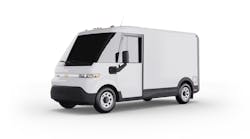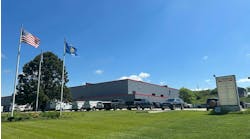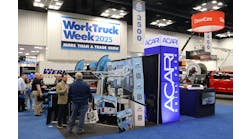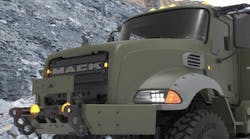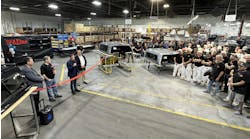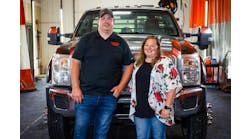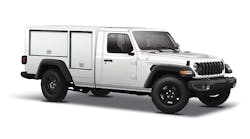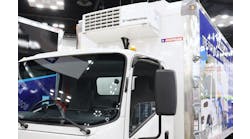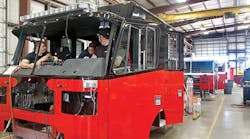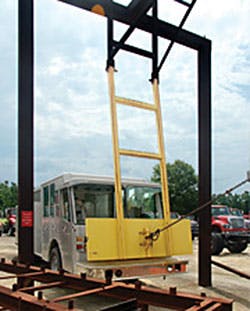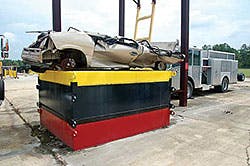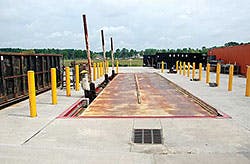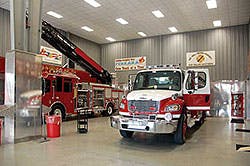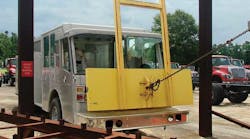Ferrara Fire Apparatus responds to fire emergencies—instead of creating them
FIRST responders have plenty of things on their mind when they are racing to an emergency. The reliability and safety of their equipment should not be one of them.
There’s a lot riding on and in these vehicles. That’s why more regulations apply to fire apparatus than just about any segment of the truck industry.
And when a company manufactures the complete vehicle—body as well as chassis—as Ferrara Fire Apparatus Inc has done since 1998, the list of national and international standards that must be met becomes exceptionally long.
An extensive engineering department makes sure that the Holden, Louisiana, company meets or exceeds those regulations. A series of test equipment at the company’s manufacturing plant attempts to crush, smash, and roll over these new products in order to prove that they meet applicable regulations and exceed customer expectations.
For example, when Ferrara Fire Apparatus was developing its Inferno/Igniter custom chassis a few years ago, the company did not just build a cab to perform strength test. It built the entire vehicle, complete with body and equipment—including a midship pump and booster tank.
“We built an entire fire truck and then dropped a bunch of weight on it,” says Chris Ferrara, president.
The Economic Commission for Europe Structural Standards has a test procedure (ECE-29) that has been adapted as for use in the United States. It involves placing a 22,000-pound vertical load in the vehicle. Ferrara Fire Apparatus engineers did that and then put an extra 4,400-pound load on the truck. The cab incurred no damage, even with the extra load placed on it.
Engineers, however, continued to test the roof strength. They subsequently loaded it to 54,300 pounds and then 65,979 pounds. They discovered the roof could withstand forces that were more the three times the ECE standard.
What about the body of the fire truck? The ECE standard does not apply to the body, but Ferrara engineers decided to test it, too. They placed the same 65,979 pounds on the extruded aluminum body and found that it, too, could handle extreme loading.
Ferrara engineers also designed a frontal impact test stand that simulates an 18.2-mph head-on collision. The stand essentially is a pendulum that is lifted up 11 feet and then released to strike the front of the vehicle.
In testing its Inferno/Igniter chassis, Ferrara loaded the pendulum with 3,736 pounds of weight, 27% more than the ECE-29 standard requires. To pass this test, the passenger cannot be compromised and the cab must stay attached to the frame. The Inferno/Igniter cab withstood the impact. Structural components remained intact, with the doors remaining closed during the impact but continuing to open and close afterward.
Rollover concerns
Fire departments are deeply concerned about getting crews to the scene safely. High speeds and high centers of gravity work against them, increasing the risk of rollover accidents. And sloshing water inside onboard storage tanks also affects stability, which is why regulations require water tanks to have baffles at specific intervals to moderate fluctuations in vehicle center of gravity.
“The goal is to keep all wheels on the ground at all times,” says Paul Christiansen, vice-president of sales and marketing.
Approximately two-thirds of Ferrara customers are ordering electronic stability control as a means of fighting rollover, Christiansen says. For those who don’t, one option is to make sure the vehicle’s center of gravity is within specified limits. However, Ferrara does not see that as a desirable option for them.
“We do not offer CG calculations because centers of gravity can change,” Christiansen says. “And everything we do is custom.”
A more effective approach, Ferrara believes, is tilt testing. The company can effectively evaluate the rollover potential through the use of a tilt table that the company operates in its test area behind the plant.
Ferrara’s tilt table can lift a vehicle 40 degrees relative to the ground, more than enough for current regulations. National Fire Protection Association (NFPA) regulation 1901 specifies that the apparatus shall remain stable to 26.5 degrees in both directions when tested on a tilt table. (For details on tilt testing fire apparatus, see story in the June issue of Trailer/Body Builders, Page 20 or click http://trailer-bodybuilders.com/truck-bodies/how-tilt-test-fire-apparatus).
The ability of the tilt table to greatly exceed the requirements for fire apparatus enables Ferrara to make the table available to other manufacturers.
“A number of other companies have used it to check the stability of their own products,” Christiansen says.
Pumping out new products
The testing is frequent because Ferrara continues to introduce new products. In November 2013, the company introduced its latest chassis, the Ferrara Cinder. The Cinder shares the same design and construction as other Ferrara chassis, but it is designed as an entry-level custom chassis.
The Cinder features an extruded aluminum roll cage sub-frame fortified by 3/16” thick marine-grade aluminum plate walls, floor, ceiling, door panels, and engine tunnel.
The new chassis made it out of the Ferrara torture chamber in good shape after enduring a 65,979-pound vertical load and a 3,736-pound frontal impact.
The testing will continue because of the approach Ferrara takes to the market.
“We are a custom builder,” Christiansen says. “If it’s unsafe, illegal, or structurally unsound, we won’t build it. Otherwise we give the customer what he wants.” ♦
__________________
Click here to view all large photos and captions
for Ferrara Fire Apparatus
